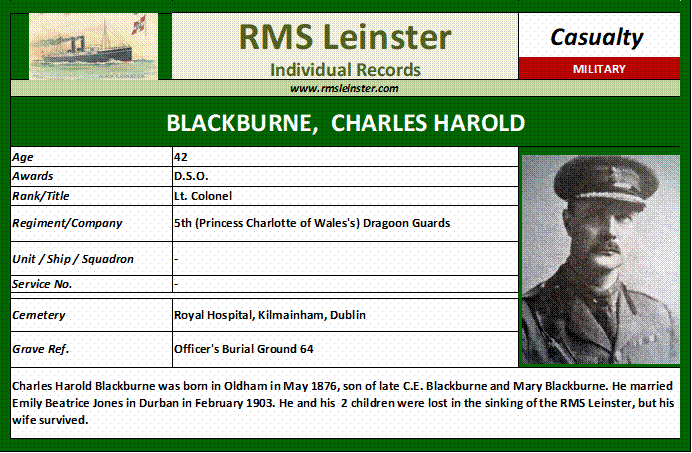 |
 |
 |
||||||
People on board
BLACKBURNE, Charles Harold Charles Harold Blackburne was born in Oldham, Lancashire on the 20th May 1876 to Charles Edward Blackburne, a solicitor, and Mary Riley. He was the third of four boys, an older sister having died in infancy. The family moved to Hastings in Sussex for the father’s health, but he died there in January 1878 at the age of thirty-two, just months before his youngest son was born. Mary Blackburne remarried in Hastings in 1881 and a daughter was born in 1885. Charles was a lively child and young man, not academic but a natural leader, and deeply interested in horses, a talented horseman. In 1898 he went to Canada and, largely unsuccessfully, was part of the Klondike Gold Rush. Hearing of the Boer War he returned to England in December 1899 and he and his youngest brother Harry enlisted as Privates in the West Kent Imperial Yeomanry. Their eldest brother Jack had already enlisted and was in Capetown. Charles’s skills with both horses and men meant he was rapidly promoted to Lance Corporal and then Sergeant, and Captain. He came home on leave in December 1901 and became engaged to his childhood friend, Emily Beatrice (Bee) Jones, daughter of the local Rector. At this time also, he received the Distinguished Service Order. Returning to South Africa, the war soon ended and he took up a permanent position as General Manager of the Transvaal Horse Breeding Department with a salary of £750 a year. He was then in a position to marry but, as he could not be spared the leave to return to England, Bee and her father, Canon Jones, travelled out to South Africa. The wedding took place in Durban on the 10th February 1903. The wedding ring was made from a nugget of Klondike gold that Charles had kept for this purpose. In November a daughter was born who only lived for eleven days. Life in the Transvaal was not always easy and after a riding accident and an attack of enteric fever, Bee was advised to return to England which she did in July 1905. Charles followed in December and was offered a job as Managing Director of White’s Carriage Company in Liverpool, which allowed him to give up his position in South Africa. In June 1907 a daughter, Beatrice Audrey, was born. Shortly after, Charles purchased a property, Tyddyn, near Mold in North Wales, which was close enough to Liverpool for his work, but, with 250 acres, also provided the lifestyle of a country gentleman. In September 1911 a son, Charles Bertram, known as Peter, was born.
In early 1916 he joined the staff of the 7th Reserve Cavalry Brigade, stationed in the Curragh in Co Kildare. On Easter Monday Charles Blackburne was at the Fairyhouse Races when he heard of the Rebellion in Dublin. He was principal staff officer to General Lowe, who was in charge of the British Army response, and was deeply involved in the action all the following week. According to the memoir that his brother Lionel wrote, Charles was also very aware of the peaceful citizens of Dublin. He was promoted within the Headquarters Staff of the Irish Command, and having lived the bachelor life in Kildare Street, close to the Kildare Street Club, he decided that his family should join him in Ireland. They arrived in January 1918 and lived for a few months in Bellville, in the Phoenix Park, later moving to Hatch Street close to the city centre. The business in Liverpool had suffered badly in the war and he decided to sell up, including the property in Mold. In order to qualify for permanent staff work after the war he chose to go on a senior staff course in Cambridge. It was for this reason that he and Bee and the two children were on board RMS Leinster on the 10th October. They were accompanied by the children’s governess Rose de Pury. Charles and the two children did not survive the sinking, nor did Rose de Pury, though Bee was rescued. The last sighting of Charles Blackburne was of him swimming as best he could, with his daughter Audrey on his back. Her body was never recovered nor that of Rose de Pury. On the 14th of October the Church of Ireland Primate, Dr John Crozier, held a funeral service in the Royal Hospital, Kilmainham in Dublin. The hospital cemetery, which had been unused for many years, was opened on the orders of the Viceroy and Charles Blackburne and his son Peter were laid to rest there. The commander of the British Army in Ireland and his staff were present, as well as many officers and friends. All Blackburne photographs from “CHARLES” by Lionel E. Blackburne, publ. 1919
|
||

 When war was declared in 1914 Charles immediately responded and had landed in France in August with the Dragoon Guards and took part in the battle of Mons, the first major battle of the war. He was then involved in the first battle of Ypres and was wounded in the shoulder in the second battle of Ypres in May 1915. He was treated in hospital in Liverpool, but never regained the full use of his arm. He was mentioned in dispatches for his bravery and made Brevet Major.
When war was declared in 1914 Charles immediately responded and had landed in France in August with the Dragoon Guards and took part in the battle of Mons, the first major battle of the war. He was then involved in the first battle of Ypres and was wounded in the shoulder in the second battle of Ypres in May 1915. He was treated in hospital in Liverpool, but never regained the full use of his arm. He was mentioned in dispatches for his bravery and made Brevet Major.